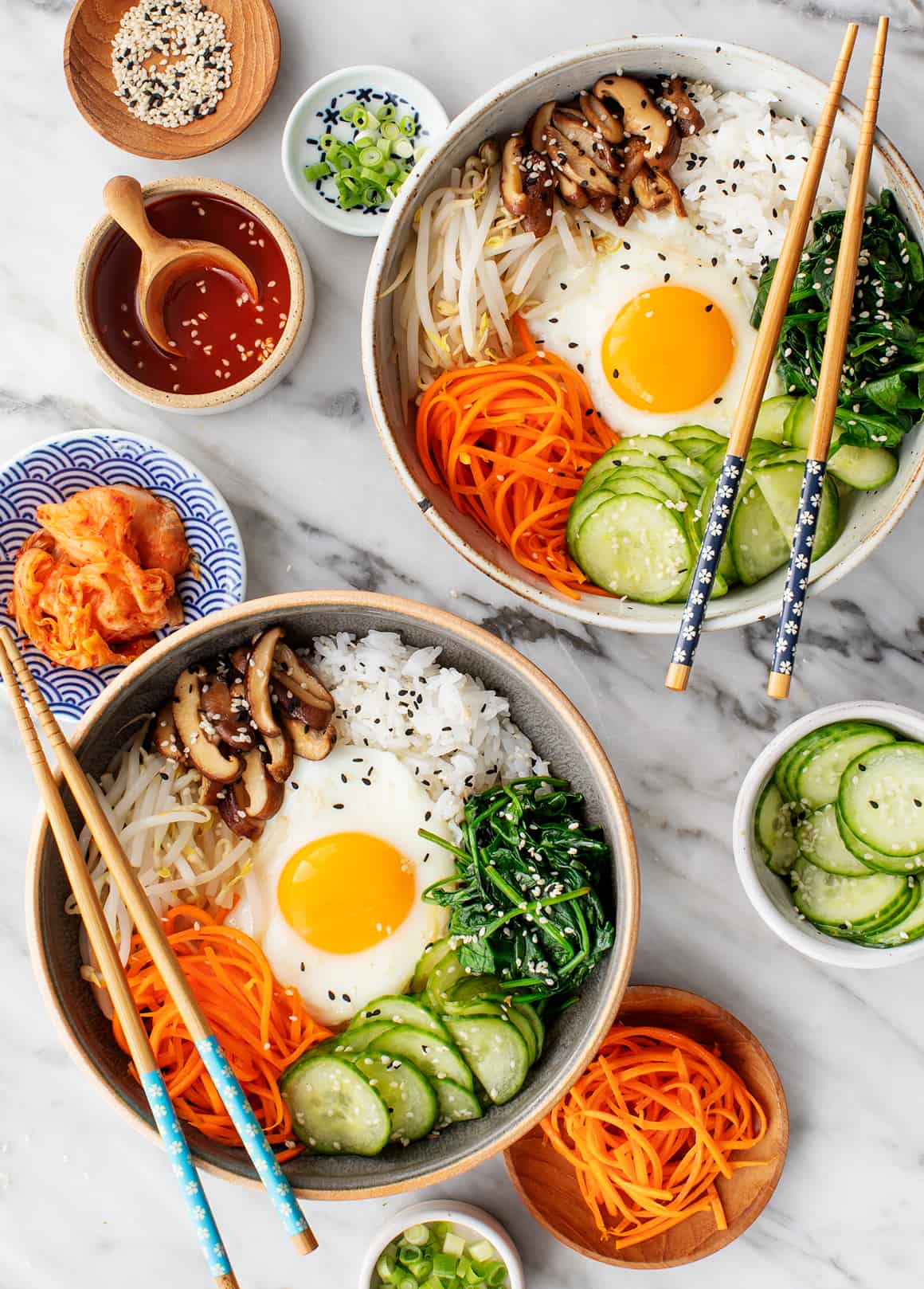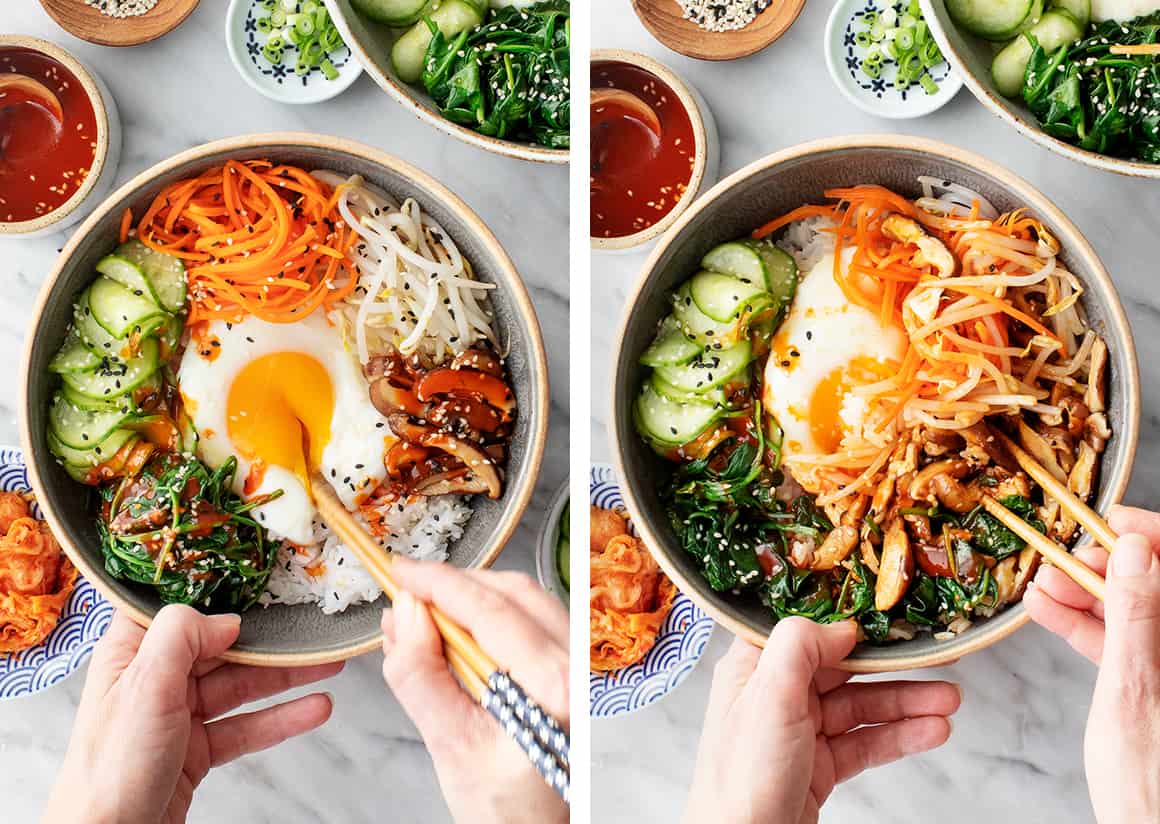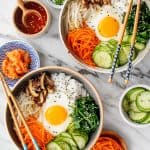This bibimbap recipe is my spin on the famous Korean dish. I top this delicious rice bowl with gochujang sauce, seasoned veggies, and a fried egg.

This bibimbap recipe might be my favorite rice bowl I’ve ever made…and I’ve made a lot of them! My spin on Korean bibimbap, it consists of white rice topped with seasoned vegetables and a fried egg. I serve it with a sweet and spicy bibimbap sauce that absolutely PACKS this bowl with flavor. It’s delicious—I hope you try it!
What is bibimbap?
Bibimbap is one of the most well known Korean dishes. It’s a rice bowl topped with assorted vegetables, spicy gochujang, and an egg and/or meat, often beef. Each component contributes something unique to the bowl—think richness, heat, or crunch. The components are meant to be mixed together before eating—the Korean word “bibimbap” translates to “mixed rice” in English.
Of course, my recipe is meat-free, but the vegetables and punchy sauce still fill it with a fabulous combination of textures and flavors.

Ingredients
My bibimbap recipe starts with two base components:
- Rice – White rice is traditional for bibimbap, but brown rice or cauliflower rice would work here too.
- A fried egg – Traditional bibimbap is sometimes topped with a raw egg yolk, but I like to use a cooked sunny side up egg on mine. If you’re vegan, skip the egg, or replace it with baked tofu or tempeh.
Bibimbap Vegetables
Then, I add the veggies! I like to use these:
- Cucumber – I thinly slice cucumber and marinate it with rice vinegar and sesame oil to give it tangy, nutty flavor.
- Bean sprouts – Lightly blanched, they add a delicious crunch to this bowl.
- Shredded carrots – I lightly sauté them in sesame oil so that they soften just slightly. I use my julienne peeler to cut the carrots here, but if you don’t have one, grated carrots will work just as well.
- Sautéed shiitake mushrooms – To highlight their rich umami flavor, I cook them with a little rice vinegar and tamari or soy sauce.
- Sautéed spinach – Sesame oil and tamari or soy sauce give it toasty, savory flavor. Make sure to squeeze the excess liquid out of the spinach after you cook it so that your bibimbap isn’t watery.
Feel free to use other veggies if you like. This bibimbap recipe works well with a wide assortment of vegetables. Swap in steamed or sautéed cabbage, bok choy, daikon, or any veggie you love. You can also simplify your bowl by using just two or three veggies.
Find the complete recipe with measurements below.
My Bibimbap Sauce
Bibimbap is typically served with some type of gochujang sauce. Gochujang is a Korean fermented chili paste with a bold sweet, spicy, and umami flavor.
For this recipe, I make a simple bibimbap sauce out of gochujang, rice vinegar, sesame oil, and maple syrup. Sweet, spicy, and a little funky, it adds amazing flavor to this rice bowl! See my gochujang sauce recipe to learn more about it.

Assembling and Eating Bibimbap
To make this recipe, start by cooking the rice. Use my method for how to cook rice on the stove, or make Instant Pot rice if you prefer.
Meanwhile, prep the remaining components:
- Whisk together the sauce.
- Prep the veggies. Start with the cucumber so that it has time to marinate. Then, blanch the bean sprouts, and sauté the carrots, mushrooms, and spinach.
- Lastly, fry the eggs.

Once the components are ready, you can assemble the bowls. Fill each with a base of cooked rice, and top it with an egg. Place the vegetables in sections around the perimeter of the bowl, surrounding the egg, and drizzle with the sauce.
When you’re ready to eat, break the egg yolk and mix the components together. The runny egg yolk and sauce will combine to coat the rice and veggies, which makes the bowl really flavorful and fun to eat.
I like to serve my bibimbap with extra sauce, sliced green onions, and kimchi on the side and mix them in as I eat. Feel free to skip these components, or add them to your bowl from the get-go. Again, this recipe is flexible, so customize it to create a bowl you love!
Find the complete recipe with measurements below.
Tip: These bibimbap components are simple to make, but prepping them all at once takes time.
Get ahead by prepping the sauce and veggies in advance. They’ll keep well in the fridge for up to 3 days.

More Rice Bowl Recipes
If you love this bibimbap recipe, try one of these rice bowls next:

Bibimbap
Ingredients
- ½ English cucumber, thinly sliced
- ½ teaspoon rice vinegar
- 1¼ teaspoons toasted sesame oil
- 1 cup fresh mung bean sprouts
- 1 cup shredded carrots
- 4 cups baby spinach
- ½ teaspoon tamari or soy sauce
- 2 cups cooked short-grain white rice
- 2 fried eggs, or 1 cup cubed baked tofu
- 4 ounces sautéed shiitake mushrooms, optional
- 1 recipe Gochujang Sauce
- Sesame seeds
- Sea salt
- Kimchi, optional, for serving
- Chopped scallions, optional, for serving
Instructions
- In a small bowl, toss the cucumber slices with the rice vinegar, ¼ teaspoon of the sesame oil, and a pinch of salt. Set aside.
- Bring a small pot of water to a boil. Drop in the bean sprouts and cook for 1 minute. Drain and set aside.
- Heat another ½ teaspoon of the sesame oil in a medium skillet over medium heat. Add the carrots and a pinch of salt. Cook, stirring, for 1 to 2 minutes, or until a little bit soft, and then remove from the pan and set aside. Heat the remaining ½ teaspoon sesame oil in the skillet and add the spinach and tamari. Cook, tossing, for 30 seconds, or until just wilted. Remove from the skillet and gently squeeze out any excess water from the spinach.
- Assemble the bowls with the rice, cucumber slices, bean sprouts, carrots, and spinach. Top with a fried egg or baked tofu. Add the mushrooms, if using. Sprinkle with sesame seeds and drizzle generously with the gochujang sauce. Serve with kimchi and scallions, if desired, and the remaining gochujang sauce on the side.














Loved this recipe! All the kids liked it too. I left some raw shredded carrots for the boys who don’t like cooked ones. Will definitely make again!
Soooo good
Delicious! I sautéed shiitake mushrooms with garlic and tossed them with the carrots. And I second Mother in Laws gochujang! I added a little garlic ginger and rice wine to it for a decadent sauce. Thanks for another outstanding recipe!
So glad you loved it!
I’d love instructions on how you’re preparing your mushrooms.
nevermind. 🙂
Delicious – made as written but used black rice